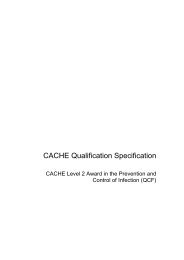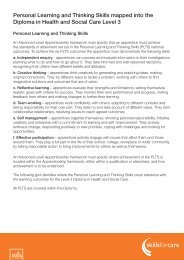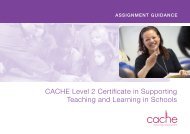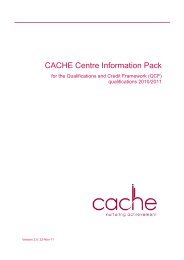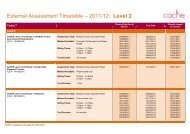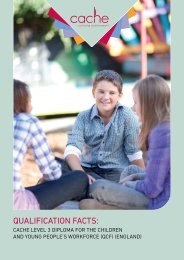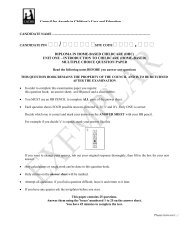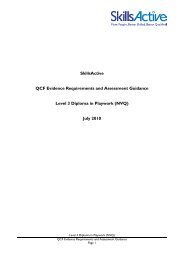Finding the level:Layout 1 - Cache
Finding the level:Layout 1 - Cache
Finding the level:Layout 1 - Cache
Create successful ePaper yourself
Turn your PDF publications into a flip-book with our unique Google optimized e-Paper software.
<strong>Finding</strong> <strong>the</strong> <strong>level</strong>
Contents<br />
Introduction<br />
Section 1 - Levels of Skill 2<br />
Section 2 - Entry Level 3<br />
Section 3 - Level 1 5<br />
Section 4 - Level 2 7<br />
Section 5 - Level 3 11<br />
Section 6 - Level 4 16<br />
Section 7 - Supporting learners to meet <strong>the</strong> assessment criteria 20<br />
Section 8 - Fur<strong>the</strong>r guidance for tutors and trainers 21<br />
Section 9 - Glossary of terms used in assessment or in assessment tasks 22<br />
Section 10 - Word limits 26<br />
CACHE <strong>Finding</strong> <strong>the</strong> Level 2009
Introduction<br />
The aim of this document is to help tutors and trainers understand <strong>the</strong> assessment<br />
requirements at each <strong>level</strong> of CACHE qualifications and awards from Entry to Level 4.<br />
This guide may be used to support learners in <strong>the</strong>ir study and preparation for internal<br />
and external assessments.<br />
The guide contains explanations of <strong>the</strong> terminology used in assignment criteria and<br />
external assessments in addition to <strong>the</strong> expectations of CACHE at each <strong>level</strong>.<br />
Learners are required to demonstrate a range of skills appropriate to <strong>the</strong> <strong>level</strong> of <strong>the</strong><br />
qualification or award. These skills are:<br />
• Recall of knowledge and understanding<br />
• Application of knowledge and understanding<br />
• Analysis<br />
• Evaluation<br />
This guide should be used in conjunction with <strong>the</strong>:<br />
• Candidate handbooks<br />
• Assessment criteria<br />
• Assignment guidance for <strong>the</strong> qualification<br />
• Guidance for awarding marks (compensatory marking) where appropriate.<br />
PAGE 01 CACHE <strong>Finding</strong> <strong>the</strong> Level 2009
Section 1<br />
Levels of skills<br />
Recall of knowledge<br />
and understanding<br />
Application of knowledge<br />
and understanding<br />
Learners will<br />
• Show a basic <strong>level</strong> of understanding of all<br />
learning outcomes<br />
• Relate known solutions to situations which<br />
reflect <strong>the</strong> learning outcomes<br />
• Know common terms, specific facts, suitable<br />
procedures and basic principles<br />
Learners will<br />
• Use understanding to apply <strong>the</strong> knowledge<br />
within each learning outcome<br />
• Apply knowledge and understanding to<br />
situations within <strong>the</strong> learning outcomes<br />
• Interpret information and relate this<br />
appropriately to areas of knowledge<br />
• Show understanding of <strong>the</strong> meaning of<br />
common terms, specific facts suitable<br />
procedures and basic principles<br />
PAGE 02 CACHE <strong>Finding</strong> <strong>the</strong> Level 2009<br />
Analysis<br />
Evaluation<br />
Learners will<br />
• Analyse issues and situations to apply <strong>the</strong><br />
appropriate knowledge and understanding<br />
• Make reasoned judgments<br />
• Apply knowledge and understanding to a<br />
range of complex situations<br />
• Show understanding of relevant <strong>the</strong>ories<br />
and concepts<br />
Learners will<br />
• Apply an in-depth understanding to a<br />
broad base of knowledge within a defined<br />
learning outcome<br />
• Evaluate well-defined and complex situations<br />
and respond using an in-depth understanding<br />
• Evaluate and apply detailed information<br />
• Analyse and apply <strong>the</strong>ories and concepts<br />
Return to contents
Section 2<br />
Entry Level<br />
Expectations of CACHE assessment at Entry Level<br />
Learners must demonstrate:<br />
• a basic knowledge and understanding of <strong>the</strong> learning gained on <strong>the</strong> qualification<br />
• that <strong>the</strong>y can apply <strong>the</strong>ir learning gained on <strong>the</strong> qualification to everyday situations<br />
• that <strong>the</strong>y are able to communicate simple ideas<br />
The assessment is based on:<br />
• 80% recall of knowledge and understanding<br />
• 20% application of knowledge and understanding<br />
Explanation of terms when used at Entry Level<br />
Contribute to<br />
Demonstrate<br />
Describe<br />
Explain<br />
Give (an example of…)<br />
Identify<br />
Give ideas or opinions about <strong>the</strong> subject.<br />
Show an understanding of <strong>the</strong> subject.<br />
Provide some details about <strong>the</strong> subject or item.<br />
Provide some details about <strong>the</strong> subject with simple<br />
reasons showing how or why.<br />
Provide a relevant example to support <strong>the</strong> subject.<br />
List or name some of <strong>the</strong> main points.<br />
PAGE 03 CACHE <strong>Finding</strong> <strong>the</strong> Level 2009<br />
Indicate<br />
Label<br />
List<br />
Name<br />
Order<br />
Plan<br />
Respond to<br />
Show<br />
State<br />
Point out or show.<br />
Give <strong>the</strong> correct name to identify <strong>the</strong> subject.<br />
Make a list of words, sentences or comments.<br />
Give <strong>the</strong> correct words which identify <strong>the</strong> subject.<br />
Arrange in a logical way.<br />
Think about, organise and give information in a logical<br />
way. This could be presented as written information, a<br />
diagram or an illustration.<br />
Reply or answer in words<br />
Give some information that includes knowledge about<br />
<strong>the</strong> subject<br />
Give some of <strong>the</strong> main points in brief,<br />
clear sentences.
Diversity and Inclusion at Entry Level<br />
Expectations are for brief simple statements which show learners understand that:<br />
• Children have individual needs<br />
• Children should be valued as individuals<br />
• All children and families should be respected<br />
References and Bibliography at Entry Level<br />
References and bibliography are not required at this <strong>level</strong>.<br />
Return to contents<br />
PAGE 04 CACHE <strong>Finding</strong> <strong>the</strong> Level 2009
Section 3<br />
Level 1<br />
Expectations of CACHE assessment at Level 1<br />
Learners must demonstrate:<br />
• a basic knowledge and understanding of <strong>the</strong> learning gained on <strong>the</strong> qualification<br />
• that <strong>the</strong>y can begin to apply <strong>the</strong>ir knowledge and understanding to practice or to<br />
everyday situations<br />
• that <strong>the</strong>y are able to communicate simple ideas<br />
The assessment is based on:<br />
• 60% recall of knowledge and understanding<br />
• 40% application of knowledge and understanding<br />
Explanation of terms used at Level 1<br />
Define<br />
Demonstrate<br />
Describe<br />
Explain<br />
Give (examples of…)<br />
Give <strong>the</strong> meaning of a word or phrase.<br />
Show an understanding of <strong>the</strong> subject.<br />
Provide details about <strong>the</strong> subject or item.<br />
Provide details about <strong>the</strong> subject with reasons showing<br />
how or why.<br />
Provide relevant examples to support <strong>the</strong> subject.<br />
PAGE 05 CACHE <strong>Finding</strong> <strong>the</strong> Level 2009<br />
Identify<br />
Indicate<br />
Locate<br />
List<br />
Outline<br />
Plan<br />
Show<br />
State<br />
List or name <strong>the</strong> main points.<br />
Point out or show using words, illustrations<br />
or diagrams.<br />
Find or identify.<br />
Make a list of words, sentences or comments.<br />
Identify or describe <strong>the</strong> main points.<br />
Think about, organise and present information in<br />
a logical way. This could be presented as written<br />
information, a diagram or an illustration.<br />
Give information that includes clear knowledge about<br />
<strong>the</strong> subject<br />
Give <strong>the</strong> main points in brief, clear sentences.<br />
Use<br />
Take an item, resource or piece of information and link<br />
to <strong>the</strong> question or task
Diversity and Inclusion at Level 1<br />
Expectations are for brief simple statements which show learners understand that:<br />
• Children have individual needs<br />
• Children should be valued as individuals<br />
• All children and families should be respected<br />
References and Bibliography at Level 1<br />
References and bibliography are not required at this <strong>level</strong>.<br />
Return to contents<br />
PAGE 06 CACHE <strong>Finding</strong> <strong>the</strong> Level 2009
Section 4<br />
Level 2<br />
Expectations of CACHE assessment at Level 2<br />
Learners must demonstrate:<br />
• a sound knowledge and understanding of <strong>the</strong> learning gained on <strong>the</strong> qualification<br />
• that <strong>the</strong>y can apply <strong>the</strong>ir knowledge and understanding gained on <strong>the</strong> qualification<br />
and link this to <strong>the</strong>ir own practice<br />
• that <strong>the</strong>y can work with o<strong>the</strong>rs under general supervision and can take some<br />
responsibility for <strong>the</strong>ir own actions<br />
• that <strong>the</strong>y are able to communicate and record information accurately<br />
The assessment is based on:<br />
• 40% recall of knowledge and understanding<br />
• 50% application of knowledge and understanding<br />
• 10% analysis<br />
PAGE 07 CACHE <strong>Finding</strong> <strong>the</strong> Level 2009
Explanation of terms used at Level 2<br />
PAGE 08 CACHE <strong>Finding</strong> <strong>the</strong> Level 2009<br />
Apply<br />
Assess<br />
Classify<br />
Compare<br />
Define<br />
Demonstrate<br />
Describe<br />
Differentiate<br />
Discuss<br />
Distinguish<br />
Estimate<br />
Explain<br />
Give (positive and<br />
negative points….)<br />
Identify<br />
Illustrate<br />
List<br />
Plan<br />
Perform<br />
Provide<br />
Reflect<br />
Link existing knowledge to new or different situations.<br />
Consider information in order to make decisions.<br />
Organise according to specific criteria.<br />
Examine <strong>the</strong> subjects in detail looking at similarities and<br />
differences<br />
State <strong>the</strong> meaning of a word or phrase.<br />
Show an understanding of <strong>the</strong> subject or how to apply<br />
skills in a practical situation.<br />
Write about <strong>the</strong> subject giving detailed information.<br />
Give <strong>the</strong> differences between two or more things<br />
Write an account giving more than one view or opinion.<br />
Show or recognise <strong>the</strong> difference between<br />
items/ideas/information<br />
Give an approximate decision or opinion using<br />
previous knowledge.<br />
Provide details about <strong>the</strong> subject with reasons showing<br />
how or why. Some responses could include examples.<br />
Provide information showing <strong>the</strong> advantages and<br />
disadvantages of <strong>the</strong> subject.<br />
List or name <strong>the</strong> main points. (Some description may<br />
also be necessary to gain higher marks when using<br />
compensatory marking).<br />
Give clear information using written examples, pictures<br />
or diagrams.<br />
Make a list of key words, sentences or comments that<br />
focus on <strong>the</strong> subject<br />
Think about and organise information in a logical way.<br />
This could be presented as written information, a<br />
diagram, an illustration or o<strong>the</strong>r suitable format.<br />
Do something (take an action/follow an instruction)<br />
which <strong>the</strong> question or task asks or requires<br />
Give relevant information about a subject<br />
Learners should look back on <strong>the</strong>ir actions, experiences<br />
or learning and think about how this could inform <strong>the</strong>ir<br />
future practice.
Explanation of terms used at Level 2<br />
Select<br />
Show<br />
State<br />
Use<br />
Choose for a specific purpose<br />
Supply sufficient evidence to demonstrate knowledge<br />
and understanding.<br />
Give <strong>the</strong> main points clearly in sentences<br />
Take or apply an item, resource or piece if information as<br />
asked in <strong>the</strong> question or task<br />
Diversity and Inclusion at Level 2<br />
Expectations are for learners to show an understanding that:<br />
• Children have individual needs<br />
• Children should be valued as individuals<br />
• All children and families should be respected<br />
AND<br />
• Show how each of <strong>the</strong>se expectations can be applied in practical ways<br />
• There may be some reference to policy and/or legislation<br />
References and Bibliography at Level 2<br />
PAGE 09 CACHE <strong>Finding</strong> <strong>the</strong> Level 2009<br />
• In each assessment task learners need to provide at least 2 relevant references and<br />
a bibliography.<br />
• The references may come from <strong>the</strong> same source or different sources.<br />
• References should be used in <strong>the</strong> main body of <strong>the</strong> assignment to support <strong>the</strong><br />
learners’ own work.<br />
• Each reference should be clearly identified by <strong>the</strong> use of speech marks, bold writing<br />
or italics and should also indicate where <strong>the</strong> information has been taken from.<br />
If references are not clearly identified, this could be considered to be plagiarism.<br />
“It is important to follow all <strong>the</strong> policies and procedures in order to keep children<br />
safe.” (Bloggs, 2009, p26)<br />
Or<br />
According to Bloggs, 2009, p26 It is important to<br />
• A bibliography is a list of books, websites, magazines articles, DVDs or o<strong>the</strong>r<br />
relevant sources may be used. The bibliography should contain <strong>the</strong> sources of<br />
<strong>the</strong> references toge<strong>the</strong>r with any o<strong>the</strong>r background reading used when writing<br />
<strong>the</strong> assignment.<br />
• The information in <strong>the</strong> bibliography should be sufficient to enable <strong>the</strong> reader to find<br />
<strong>the</strong> source.
Level 2<br />
For each book learners need to include:<br />
• The name of <strong>the</strong> author(s)<br />
• The year of publication<br />
• The title<br />
• The publisher:<br />
Bloggs J (2009) Planning for Children, Smith and Co.<br />
For each website learners need to include:<br />
• The full web address or URL<br />
• The date you accessed <strong>the</strong> information:<br />
www.direct.gov.uk/en/parents 01/04/09<br />
For each journal or magazine learners need to include:<br />
• The name of <strong>the</strong> author of <strong>the</strong> article<br />
• The title of <strong>the</strong> article<br />
• The name of <strong>the</strong> journal or magazine<br />
• The date of publication:<br />
Bloggs J. Planning for <strong>the</strong> under 5’s, The New Nursery, 8th April 2009<br />
• Where <strong>the</strong> compensatory marking system is used, marks will be awarded according<br />
to <strong>the</strong> breadth of reading and research and use of appropriate referencing.<br />
• The majority of <strong>the</strong> assignment should be <strong>the</strong> learners’ own work, <strong>the</strong>refore <strong>the</strong>y<br />
should be discouraged from copying large extracts from any source.<br />
PAGE 10 CACHE <strong>Finding</strong> <strong>the</strong> Level 2009<br />
Return to contents
Section 5<br />
Level 3<br />
Expectations of CACHE assessment at Level 3<br />
Learners must demonstrate:<br />
• a comprehensive knowledge and understanding of <strong>the</strong> learning gained on<br />
<strong>the</strong> qualification<br />
• that <strong>the</strong>y can apply <strong>the</strong>ir knowledge and understanding to familiar and unfamiliar<br />
situations, using relevant <strong>the</strong>ories and research to support <strong>the</strong>ir written work<br />
• that <strong>the</strong>y are able to direct <strong>the</strong>ir own work and take responsibility for <strong>the</strong>ir actions<br />
• that <strong>the</strong>y can relate <strong>the</strong>ory to practice, reflect on <strong>the</strong>ir own work and on <strong>the</strong> work<br />
of o<strong>the</strong>rs<br />
• that <strong>the</strong>y can communicate and record information clearly and accurately, using<br />
appropriate terms and in a range of ways<br />
The assessment is based on:<br />
• 30% recall of knowledge and understanding<br />
• 45% application of knowledge and understanding<br />
• 20% analysis<br />
• 5% evaluation<br />
PAGE 11 CACHE <strong>Finding</strong> <strong>the</strong> Level 2009
Explanation of terms used at Level 3<br />
PAGE 12 CACHE <strong>Finding</strong> <strong>the</strong> Level 2009<br />
Apply<br />
Analyse<br />
Clarify<br />
Classify<br />
Collate<br />
Compare<br />
Critically compare<br />
Consider<br />
Demonstrate<br />
Describe<br />
Develop (a<br />
plan/idea which….)<br />
Diagnose<br />
Differentiate<br />
Discuss<br />
Distinguish<br />
Draw conclusions<br />
(which….)<br />
Explain how existing knowledge can be linked to new or<br />
different situations in practice.<br />
Break <strong>the</strong> subject down into separate parts and examine<br />
each part. Show how <strong>the</strong> main ideas are related and why<br />
<strong>the</strong>y are important. Reference to current research or<br />
<strong>the</strong>ory may support <strong>the</strong> analysis.<br />
Explain <strong>the</strong> information in a clear, concise way.<br />
Organise according to specific criteria.<br />
Collect and present information arranged in sequence or<br />
logical order.<br />
Examine <strong>the</strong> subjects in detail and consider <strong>the</strong><br />
similarities and differences.<br />
This is a development of compare where <strong>the</strong> learner<br />
considers <strong>the</strong> positive aspects and limitations of<br />
<strong>the</strong> subject.<br />
Think carefully and write about a problem, action<br />
or decision.<br />
Show an understanding by describing, explaining or<br />
illustrating using examples.<br />
Write about <strong>the</strong> subject giving detailed information in a<br />
logical way.<br />
Expand a plan or idea by adding more detail and/or<br />
depth of information.<br />
Identify <strong>the</strong> cause based on valid evidence.<br />
Identify <strong>the</strong> differences between two or more things.<br />
Write a detailed account giving a range of views<br />
or opinions.<br />
Explain <strong>the</strong> difference between two or more items,<br />
resources, pieces of information<br />
Make a final decision or judgment based on reasons.
Explanation of terms used at Level 3<br />
PAGE 13 CACHE <strong>Finding</strong> <strong>the</strong> Level 2009<br />
Estimate<br />
Evaluate<br />
Explain<br />
Extrapolate<br />
Identify<br />
Implement<br />
Interpret<br />
Judge<br />
Justify<br />
Plan<br />
Perform<br />
Provide<br />
Review and revise<br />
Reflect<br />
Select<br />
Show<br />
State<br />
Summarise<br />
Form an approximate opinion or judgment using previous<br />
knowledge or considering o<strong>the</strong>r information.<br />
Examine strengths and weaknesses, arguments for and<br />
against and/or similarities and differences. Judge <strong>the</strong><br />
evidence from <strong>the</strong> different perspectives and make a<br />
valid conclusion or reasoned judgement. Reference to<br />
current research or <strong>the</strong>ory may support <strong>the</strong> evaluation.<br />
Provide detailed information about <strong>the</strong> subject with<br />
reasons showing how or why. Responses could include<br />
examples to support <strong>the</strong>se reasons.<br />
Use existing knowledge to predict possible outcomes<br />
which might be outside <strong>the</strong> norm.<br />
Recognise and name <strong>the</strong> main points accurately. (Some<br />
description may also be necessary to gain higher marks<br />
when using compensatory marking)<br />
Explain how to put an idea or plan into action<br />
Explain <strong>the</strong> meaning of something.<br />
Form an opinion or make a decision<br />
Give a satisfactory explanation for actions or decisions.<br />
Think about and organise information in a logical way<br />
using an appropriate format.<br />
Carry out a task or process to meet <strong>the</strong> requirements of<br />
<strong>the</strong> question<br />
Identify and give relevant and detailed information in<br />
relation to <strong>the</strong> subject.<br />
Look back over <strong>the</strong> subject and make corrections<br />
or changes.<br />
Learners should consider <strong>the</strong>ir actions, experiences or<br />
learning and <strong>the</strong> implications of this for <strong>the</strong>ir practice<br />
and/or professional development.<br />
Make an informed choice for a specific purpose<br />
Supply evidence to demonstrate accurate knowledge<br />
and understanding.<br />
Give <strong>the</strong> main points clearly in sentences or paragraphs<br />
Give <strong>the</strong> main ideas or facts in a concise way.
Diversity and Inclusion at Level 3<br />
Expectations are for learners to show that:<br />
• They understand that children have individual needs and how <strong>the</strong>se individual<br />
needs can be met in practice<br />
• They understand that children should be valued as individuals<br />
• They understand that all children and families should be respected<br />
• They understand about <strong>the</strong> rights of children, parents and carers<br />
• They are able to apply <strong>the</strong>ir understanding of diversity and inclusion in practical<br />
situations such as:<br />
- challenging discrimination<br />
- resolving conflict<br />
- bullying<br />
- implementing legislation and policies<br />
- showing a positive attitude to all children and families.<br />
- providing an inclusive environment<br />
• There may be reference to policy and/or legislation<br />
References and Bibliography at Level 3<br />
• In each assessment task learners need to provide at least 2 relevant references and<br />
a bibliography.<br />
• The references may come from <strong>the</strong> same source or different sources.<br />
• References should be used in <strong>the</strong> main body of <strong>the</strong> assignment to support <strong>the</strong><br />
candidates’ own work.<br />
• Each reference should be clearly identified by <strong>the</strong> use of speech marks, bold writing<br />
or italics and should also indicate where <strong>the</strong> information has been taken from. If<br />
references are not clearly identified, this could be considered to be plagiarism.<br />
PAGE 14 CACHE <strong>Finding</strong> <strong>the</strong> Level 2009<br />
“It is important to follow all <strong>the</strong> policies and procedures in order to keep children<br />
safe.” (Bloggs, 2009, p26)<br />
Or<br />
According to Bloggs, 2009, p26 It is important to<br />
• A bibliography at Level 3 is a list of more than one book, website, magazine articles,<br />
DVDs or o<strong>the</strong>r relevant sources may be used. The bibliography should contain <strong>the</strong><br />
sources of <strong>the</strong> references toge<strong>the</strong>r with any o<strong>the</strong>r background reading used when<br />
writing <strong>the</strong> assignment.<br />
• The information in <strong>the</strong> bibliography should be sufficient to enable <strong>the</strong> reader to find<br />
<strong>the</strong> source.
Level 3<br />
For each book learners need to include:<br />
• The name of <strong>the</strong> author(s)<br />
• The year of publication<br />
• The title<br />
• The publisher:<br />
Bloggs J (2009) Planning for Children, Smith and Co.<br />
For each website learners need to include:<br />
• The full web address or URL<br />
• The date you accessed <strong>the</strong> information:<br />
www.direct.gov.uk/en/parents 01/04/09<br />
For each journal or magazine learners need to include:<br />
• The name of <strong>the</strong> author of <strong>the</strong> article<br />
• The title of <strong>the</strong> article<br />
• The name of <strong>the</strong> journal or magazine<br />
• The date of publication:<br />
Bloggs J. Planning for <strong>the</strong> under 5’s, The New Nursery, 8th April 2009<br />
• Where <strong>the</strong> compensatory marking system is used, marks will be awarded according<br />
to <strong>the</strong> breadth of reading and research and use of appropriate referencing.<br />
• The majority of <strong>the</strong> assignment should be <strong>the</strong> learners’ own work <strong>the</strong>refore <strong>the</strong>y<br />
should be discouraged from copying large extracts from any source.<br />
PAGE 15 CACHE <strong>Finding</strong> <strong>the</strong> Level 2009<br />
Return to contents
Section 6<br />
Level 4<br />
Expectations of CACHE assessment at Level 4<br />
Learners must demonstrate:<br />
• a comprehensive knowledge and understanding of <strong>the</strong> learning gained on<br />
<strong>the</strong> qualification<br />
• that <strong>the</strong>y can apply <strong>the</strong>ir knowledge and understanding to a range of familiar and<br />
unfamiliar situations, using a range of relevant <strong>the</strong>ories and research to support<br />
<strong>the</strong>ir written work<br />
• that <strong>the</strong>y can find solutions for a variety of unpredictable problems, some of which<br />
maybe innovative<br />
• that <strong>the</strong>y are able to direct <strong>the</strong>ir own work, take responsibility for <strong>the</strong>ir actions and<br />
<strong>the</strong> quality of <strong>the</strong>ir work<br />
• that <strong>the</strong>y can relate <strong>the</strong>ory to practice, reflect on <strong>the</strong>ir own work and on <strong>the</strong> work<br />
of o<strong>the</strong>rs<br />
• that <strong>the</strong>y are able to analyse and evaluate a broad range of information<br />
independently and use it to:<br />
- plan and develop strategies<br />
- make reasoned judgments and decisions<br />
• that <strong>the</strong>y can communicate and record information clearly and accurately,<br />
using appropriate terms and in a range of ways to meet <strong>the</strong> needs of <strong>the</strong><br />
intended audience<br />
PAGE 16 CACHE <strong>Finding</strong> <strong>the</strong> Level 2009<br />
The assessment is based on:<br />
• 20% recall of knowledge and understanding<br />
• 40% application of knowledge and understanding<br />
• 30% analysis<br />
• 10% evaluation
Explanation of terms used at Level 4<br />
PAGE 17 CACHE <strong>Finding</strong> <strong>the</strong> Level 2009<br />
Analyse<br />
Critically analyse<br />
Clarify<br />
Classify<br />
Collate<br />
Compare<br />
Critically compare<br />
Consider<br />
Demonstrate<br />
Describe<br />
Discuss<br />
Draw conclusions<br />
(which….)<br />
Evaluate<br />
Break <strong>the</strong> subject or complex situations into separate<br />
parts and examine each part in detail. Identify <strong>the</strong> main<br />
issues and show how <strong>the</strong> main ideas are related to<br />
practice and why <strong>the</strong>y are important. Reference to<br />
current research or <strong>the</strong>ory may support <strong>the</strong> analysis.<br />
This is a development of ‘analyse’ which explores<br />
limitations as well as positive aspects of <strong>the</strong> main ideas<br />
in order to form a reasoned opinion.<br />
Explain <strong>the</strong> information in a clear, concise way showing<br />
depth of understanding.<br />
Organise accurately according to specific criteria.<br />
Collect and present information arranged in sequence or<br />
logical order which is suitable for purpose.<br />
Examine <strong>the</strong> subjects in detail, consider and contrast<br />
similarities and differences.<br />
This is a development of compare where <strong>the</strong> learner<br />
considers and contrasts <strong>the</strong> positive aspects and<br />
limitations of <strong>the</strong> subject<br />
Think carefully and write about a problem, action or<br />
decision showing how views and opinions have<br />
been developed.<br />
Show an in-depth understanding by describing,<br />
explaining or illustrating using examples.<br />
Provide a broad range of detailed information about <strong>the</strong><br />
subject or item in a logical way.<br />
Write a detailed account which includes<br />
contrasting perspectives.<br />
Make a final decision or judgment based on reasons.<br />
Examine strengths and weaknesses, arguments for and<br />
against and/or similarities and differences. Judge <strong>the</strong><br />
evidence from <strong>the</strong> different perspectives and make a<br />
valid conclusion or reasoned judgment. Apply current<br />
research or <strong>the</strong>ories to support <strong>the</strong> evaluation.
Explanation of terms used at Level 4<br />
Critically evaluate<br />
Explain<br />
Identify<br />
Justify<br />
Review and revise<br />
Reflect<br />
Summarise<br />
This is a development of ‘evaluate’ where <strong>the</strong> candidate<br />
debates <strong>the</strong> validity of claims from <strong>the</strong> opposing views<br />
and produces a convincing argument to support <strong>the</strong><br />
conclusion or judgement.<br />
Apply reasoning to account for how something is or<br />
to show understanding of underpinning concepts.<br />
Responses could include examples to support<br />
<strong>the</strong>se reasons.<br />
Apply an in-depth knowledge to give <strong>the</strong> main points<br />
accurately. (A description may also be necessary to gain<br />
higher marks when using compensatory marking).<br />
Give a detailed explanation of <strong>the</strong> reasons for actions or<br />
decisions.<br />
Look back over <strong>the</strong> subject and make corrections or<br />
changes based on additional knowledge or experience.<br />
Learners should consider <strong>the</strong>ir actions, experiences or<br />
learning and <strong>the</strong> implications of <strong>the</strong>se in order to<br />
suggest significant developments for practice and<br />
professional development.<br />
Give <strong>the</strong> main ideas or facts in a concise way to develop<br />
key issues.<br />
Diversity and Inclusion at Level 4<br />
PAGE 18 CACHE <strong>Finding</strong> <strong>the</strong> Level 2009<br />
Expectations are for learners to show:<br />
• They understand that children have individual needs and how <strong>the</strong>se needs can be<br />
met in <strong>the</strong>ir practice<br />
• They understand that children should be valued as individuals<br />
• They understand that all children and families should be respected<br />
• They understand about <strong>the</strong> rights of children, parents and carers<br />
• They have a sound understanding of policy and practice and of <strong>the</strong> principles and<br />
concepts that underpin diversity and inclusion<br />
• They are able to apply <strong>the</strong>ir understanding of diversity and inclusion to <strong>the</strong>ir own<br />
practice throughout <strong>the</strong>ir assessments<br />
• They understand legislative frameworks and government initiatives and can<br />
incorporate <strong>the</strong>se into <strong>the</strong>ir practice
References and Bibliography at Level 4<br />
• In each assessment task learners need to provide a range of appropriate<br />
references and a comprehensive bibliography.<br />
• References should be used in <strong>the</strong> main body of <strong>the</strong> assessment task to support <strong>the</strong><br />
learners’ own work.<br />
• A recognised system of referencing must be used (e.g. Harvard method)<br />
• If references are not clearly identified, this could be considered to be plagiarism.<br />
• The information in <strong>the</strong> bibliography should be sufficient to enable <strong>the</strong> reader to find<br />
<strong>the</strong> source.<br />
• Where <strong>the</strong> compensatory marking system is used, marks will be awarded according<br />
to <strong>the</strong> breadth of reading and research and use of appropriate referencing.<br />
• The majority of <strong>the</strong> assignment should be <strong>the</strong> learners’ own work <strong>the</strong>refore <strong>the</strong>y<br />
should be discouraged from copying large extracts from any source.<br />
Return to contents<br />
PAGE 19 CACHE <strong>Finding</strong> <strong>the</strong> Level 2009
Section 7<br />
Supporting learners to meet <strong>the</strong> assessment<br />
criteria<br />
The learner should read each question/criteria carefully and <strong>the</strong>n:<br />
1. Identify <strong>the</strong> main subject matter, for example:<br />
play, health and safety, child development<br />
2. Focus on <strong>the</strong> command word for example:<br />
List, Describe, Explain, Discuss<br />
3. Identify how to use <strong>the</strong> command word for example:<br />
Describe how, Describe ways, Explain how, Explain why, Discuss why, Evaluate how<br />
4. Identify o<strong>the</strong>r key words or phrases which may support <strong>the</strong> main subject,<br />
for example:<br />
<strong>the</strong> age range, <strong>the</strong> importance of, <strong>the</strong> benefits of, <strong>the</strong> value of<br />
Examples of how to apply this method.<br />
“Describe <strong>the</strong> expected social development of a child aged 4 years”<br />
1. The main subject is social development<br />
2. The command word is describe<br />
3. There are no fur<strong>the</strong>r instructions in this criteria<br />
4. The o<strong>the</strong>r key words are child aged 4 years<br />
“Explain why it is important to help children to manage risk and challenge.”<br />
PAGE 20 CACHE <strong>Finding</strong> <strong>the</strong> Level 2009<br />
1. Main subject is risk and challenge<br />
2. The command word is explain<br />
3. Why gives fur<strong>the</strong>r instruction<br />
4. O<strong>the</strong>r key words are important and help children to manage<br />
“Reflect on why it is important to review your communication skills”.<br />
1. The main subject is communication skills<br />
2. The command word is reflect<br />
3. Why is a fur<strong>the</strong>r instruction<br />
4. O<strong>the</strong>r keywords are important and review<br />
Return to contents
Section 8<br />
Fur<strong>the</strong>r guidance for tutors and trainers<br />
• Encourage learners to use <strong>the</strong> assessment task in conjunction with <strong>the</strong> assessment<br />
criteria. This should give a thorough understanding of <strong>the</strong> requirements of <strong>the</strong> task<br />
and ensure all conditions of <strong>the</strong> assignment are met.<br />
For example: diversity and inclusive practice addressed throughout <strong>the</strong> assessment,<br />
staying within <strong>the</strong> word limit.<br />
• Learners should be encouraged to attempt all criteria/questions. This should give<br />
<strong>the</strong> opportunity to achieve sufficient marks to pass or gain a higher grade.<br />
• Although <strong>the</strong>re is no lower word limit for <strong>the</strong> assignments, learners should be<br />
aware that <strong>the</strong>y are more likely to pass or achieve higher grades by using sufficient<br />
words to develop <strong>the</strong>ir ideas.<br />
• Learners should be encouraged to plan <strong>the</strong>ir responses in order to:<br />
- ensure a logical progression<br />
- focus on <strong>the</strong> criteria<br />
- avoid repetition<br />
- prevent omissions<br />
• Learners should be aware of <strong>the</strong> Compensatory marking grid: Guidance for<br />
awarding marks (in Candidate Handbooks). This guidance shows how marks<br />
are awarded, reflecting <strong>the</strong> development of ideas at <strong>the</strong> <strong>level</strong> required for<br />
<strong>the</strong> qualification.<br />
PAGE 21 CACHE <strong>Finding</strong> <strong>the</strong> Level 2009<br />
• Assignment guidance for each qualification (found on CACHE website) is<br />
recommended for tutors. However, learners may also benefit from <strong>the</strong> ideas<br />
suggested in this guide.<br />
• Where appropriate, learners should be encouraged to demonstrate increased<br />
understanding and depth by:<br />
- use of examples from practice<br />
- use of relevant references<br />
- reference to <strong>the</strong>ory<br />
Return to contents
Section 9<br />
Glossary<br />
Glossary of terms used in assessment or in assessment tasks.<br />
PAGE 22 CACHE <strong>Finding</strong> <strong>the</strong> Level 2009<br />
Appendix<br />
Compensatory<br />
marking<br />
Criterion marking<br />
Curriculum<br />
framework<br />
Diversity<br />
Enabling<br />
environment<br />
Empowerment<br />
Government<br />
initiatives<br />
A collection of supplementary material, extra information<br />
or extra detail, placed at <strong>the</strong> end of <strong>the</strong> work. An<br />
appendix must support <strong>the</strong> work in <strong>the</strong> main text of<br />
<strong>the</strong> assessment.<br />
Where <strong>the</strong>re is a range of marks to award for <strong>the</strong> work<br />
submitted for each criterion and more marks are<br />
available for <strong>the</strong> higher grades. Candidates should<br />
attempt to meet all criteria from <strong>the</strong> lowest to <strong>the</strong><br />
highest, because compensatory marking does not work<br />
to <strong>the</strong>ir advantage if <strong>the</strong>y only attempt to meet <strong>the</strong><br />
criteria for a D or E grade.<br />
Where <strong>the</strong> marker makes a decision on whe<strong>the</strong>r <strong>the</strong><br />
learner has met <strong>the</strong> criteria or not and records as YES<br />
or NO.<br />
An outline or structure that underpins practice and<br />
supports professionals to create learning opportunities<br />
and experiences or courses of study. The curriculum<br />
framework is relevant to <strong>the</strong> country in which you work.<br />
For example <strong>the</strong> Early Years Foundation Stage in<br />
England, or <strong>the</strong> Foundation Phase in Wales.<br />
Children and <strong>the</strong>ir families come from a variety of<br />
backgrounds and family structures. There may be a<br />
range or variation of people’s characteristics in<br />
aspects such as gender, lifestyle, family composition,<br />
abilities, cultural and linguistic backgrounds and<br />
o<strong>the</strong>r differences.<br />
An environment which supports and encourages children<br />
to explore and express <strong>the</strong>mselves freely. The conditions<br />
should allow children to achieve <strong>the</strong>ir potential without<br />
barriers to learning.<br />
Giving children responsibilities and choices to help <strong>the</strong>m<br />
learn to take more responsibility for <strong>the</strong>mselves.<br />
The Government conducts a study or research to define<br />
and start up a nationwide statutory function or project.<br />
The reason behind government initiatives is to provide<br />
consistency of provision ra<strong>the</strong>r than local authorities or<br />
o<strong>the</strong>r agencies devising <strong>the</strong>ir own individual and varied<br />
systems for services. The Government takes <strong>the</strong> first<br />
steps and outlines how to proceed.
Glossary of terms used in assessment or in assessment tasks.<br />
PAGE 23 CACHE <strong>Finding</strong> <strong>the</strong> Level 2009<br />
Inclusion<br />
Inclusive practice<br />
International<br />
approaches<br />
Legislation<br />
Multi-disciplinary<br />
team / working<br />
Multi-agency<br />
Multi-agency<br />
working<br />
Plagiarism<br />
Ensuring that every child or young person is given<br />
equality of opportunity to access education and care by<br />
meeting <strong>the</strong> specific needs of children and <strong>the</strong>ir families.<br />
Inclusion in education and care is one aspect of inclusion<br />
in society. Taking whatever steps are necessary to<br />
ensure that every child or young person is given an equal<br />
chance of taking advantage of <strong>the</strong> opportunities offered<br />
to <strong>the</strong>m.<br />
How o<strong>the</strong>r countries both in Europe and o<strong>the</strong>r parts of<br />
<strong>the</strong> world approach play and learning. How <strong>the</strong>ir<br />
education system is structured and what <strong>the</strong> underlying<br />
principles are.<br />
A law or group of laws passed by government providing<br />
rules which must be followed. A law may be called an<br />
Act, for example The Children Act 2004.<br />
A group of professionals, each with expertise in specific<br />
areas or disciplines, who toge<strong>the</strong>r discuss and manage<br />
an individual child or young person’s care. They plan<br />
strategies toge<strong>the</strong>r, to give <strong>the</strong> best care.<br />
Representatives from several different professional<br />
organisations such as <strong>the</strong> police, local government<br />
departments such as Children’s Services, education,<br />
social services, <strong>the</strong> health service.<br />
A team of professional people from different<br />
organisations who work toge<strong>the</strong>r to produce <strong>the</strong> best<br />
outcome for <strong>the</strong> child and family.<br />
Using words or ideas of someone else and passing <strong>the</strong>m<br />
off as your own. Not acknowledging <strong>the</strong> author by<br />
stating where <strong>the</strong> material came from is Plagiarism<br />
which can be intentional or unintentional (forgetting to<br />
reference clearly).
Glossary of terms used in assessment or in assessment tasks.<br />
PAGE 24 CACHE <strong>Finding</strong> <strong>the</strong> Level 2009<br />
Policies and<br />
Procedures<br />
Portfolio<br />
Principles & Values<br />
Professional<br />
practice / skills<br />
Provision<br />
Rationale<br />
Reflective practice<br />
A policy is a written plan of action that states how <strong>the</strong><br />
setting aims to meet legal requirements. Some examples<br />
are: Health and Safety Policy, Confidentiality Policy,<br />
Behaviour Management Policy. Within each policy are a<br />
number of written procedures.<br />
A procedure gives detailed information on <strong>the</strong> course of<br />
action a practitioner should follow in order to meet <strong>the</strong><br />
legal requirements.<br />
For example: Within <strong>the</strong> Health and Safety Policy will be<br />
many procedures explaining <strong>the</strong> way to deal with a<br />
particular situation, such as accidents, illness,<br />
emergencies.<br />
A collection where <strong>the</strong> learner displays and stores work<br />
and evidence <strong>the</strong>y have ga<strong>the</strong>red. Usually a file or o<strong>the</strong>r<br />
suitable storage method.<br />
Principles - <strong>the</strong> accepted standards and rules which<br />
guide <strong>the</strong> work of all practitioners.<br />
Values – qualities considered important that guide <strong>the</strong><br />
way a person or a group works.<br />
For example -The principles and values of <strong>the</strong> Early Years<br />
sector, Playwork Principles<br />
Professional – a skilled practitioner, an expert<br />
Professional practice – <strong>the</strong> work of a professional person<br />
Professional skills – specific abilities gained through<br />
training and practice.<br />
Something supplied or provided. Care is usually<br />
provision made by <strong>the</strong> state, private, independent or<br />
voluntary sectors.<br />
An explanation of <strong>the</strong> most important reasons. For<br />
example, a rationale for planning an activity would<br />
include <strong>the</strong> reasons why this particular activity has<br />
been selected; what are <strong>the</strong> benefits, how does it link to<br />
<strong>the</strong> curriculum.<br />
Thoughtful consideration of <strong>the</strong> way a practitioner works.<br />
Practitioners constantly looking back at <strong>the</strong>ir own<br />
work/experiences in order to identify how something<br />
could be improved for future practice.
Glossary of terms used in assessment or in assessment tasks.<br />
Relevant and<br />
current research<br />
Statutory provision<br />
Theoretical<br />
approaches<br />
Theorist<br />
Theory<br />
Relevant research – study <strong>the</strong> subject under discussion<br />
carefully in order to present information in a detailed,<br />
accurate manner.<br />
Current research – research which is used at <strong>the</strong> present<br />
time to inform and influence practice and provision.<br />
Provision which is required to be provided by law.<br />
- a way of looking at something based on a <strong>the</strong>ory<br />
or <strong>the</strong>ories.<br />
- using, applying and comparing different <strong>the</strong>ories.<br />
A person who has presented <strong>the</strong>ir ideas and opinions<br />
(a <strong>the</strong>ory) about how something works or why<br />
something happens.<br />
A set of ideas, usually based on evidence and careful<br />
reasoning, which offers an explanation of how something<br />
works or why something happens.<br />
Return to contents<br />
PAGE 25 CACHE <strong>Finding</strong> <strong>the</strong> Level 2009
Section 10<br />
Word limits<br />
Word limits are indicated so that learners and tutors can consider <strong>the</strong> requirements of<br />
<strong>the</strong> assessment task.<br />
Word limits assist learners in understanding <strong>the</strong> amount of information to give. This<br />
will guide <strong>the</strong>m to include, in a concise way, only <strong>the</strong> information which is relevant to<br />
<strong>the</strong> criteria.<br />
Return to contents<br />
PAGE 26 CACHE <strong>Finding</strong> <strong>the</strong> Level 2009



